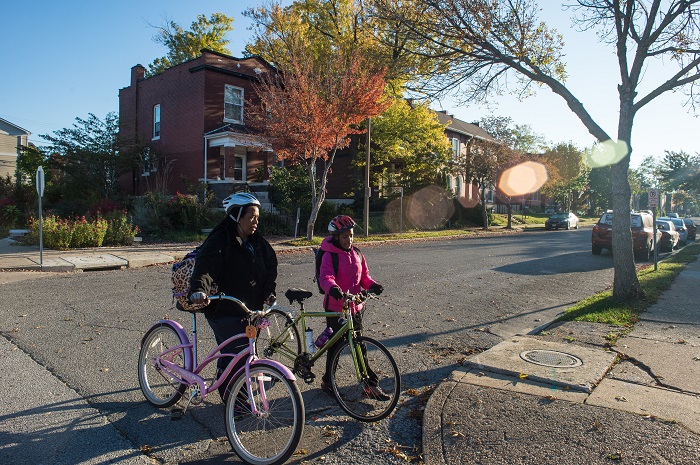A thriving St. Louis requires the recognition that all our neighborhoods and residents have the right to a livable, healthy community. Healthy food access should not require two bus rides and several dollars each way. Children walking to school in the morning should not have to gamble on whether a person driving will stop at an intersection for them to pass. Jobs should be safely reachable for everyone by car, bus, bike or train, so that all people have a chance to be successful.
However, transportation inequities caused by decades of public and private disinvestment in communities and lack of public policy solutions have resulted in isolated neighborhoods in St. Louis that are physically cut off from thriving parts of the region.
Many of these efforts were intentional: to support the white flight from urban areas to suburban communities, interstates were routed through African-American neighborhoods to ensure that the middle-class whites could continue to go to their jobs and visit cultural areas like parks and museums. During this time, discriminatory policies like redlining were additionally used to make it nearly impossible for residents of poor neighborhoods to gain financial assistance, such as mortgages, from financial institutions. From these intentional decisions, we continue to see certain neighborhoods fall behind from lack of investment and planning.
St. Louis has an opportunity to look at livability from a different point of view, a new lens. Mobility is key to opportunity. It is an essential to growing our economy and creating a more livable community for all of our residents.
Data shows we need to plan for better walking and biking infrastructure going north and south. The 38 census tracts north of Delmar are primarily African-American, have the highest number of transit users and households without vehicles, and have less population density coupled with lower life expectancy and higher concentrated poverty rates. Data also shows that these communities have less access to safe infrastructure, and this fact is reflected in the number of pedestrian deaths.
As Angela Glover Blackwell states, “Everyone wins when circumstances are created that allow those left behind to participate and contribute fully. Policies designed to benefit the most vulnerable, those living in low-income communities, and communities of color, can help everyone.”
By looking at transportation as part of the equation for livability, we can open doors that will move our city forward as a whole.
Trailnet’s Vision
For St. Louis to thrive, we need to address the barriers and recognize the assets that we have to create a livable, healthy community. From our various parks and cultural amenities to our unique neighborhoods, we know we have the destinations to become a leading city. This is why Trailnet has launched a vision for St. Louis where we connect places that matter with a cohesive network of safe infrastructure improvements for people walking and biking.
Through gathering over 4,000 responses from extensive stakeholder interviews, community and committee meetings, and surveys, we know walking and biking opportunities to parks, neighborhoods and business districts are important to the region. Most individuals shared they would enjoy improvements for walking and biking to local businesses, schools and parks safely, even if that means slowing down traffic.
This vision is guided by principles that include equity as a value. This requires an understanding of the systemic barriers within St. Louis and the role transportation planning had on community development. Trailnet is taking this information about people’s lived experiences into this vision to create a plan that addresses these inequities to help change the narrative for St. Louis.
As the planning process moves to the next phase, Trailnet will release a plan this fall of focus areas of improvements for people walking and biking. The plan will be reflective of community and civic projects in response to community input.
This vision alone will not solve the systemic issues within St. Louis, but we must develop a community supported plan that brings together our unique neighborhoods by using a safe network for walking and biking with equity as a core value to work alongside our community.
Grace Kyung is the special projects director at Trailnet and is a Robert Wood Johnson Foundation’s Culture of Health Leader. She graduated from the University of Illinois Urbana-Champaign with a Master of Public Health and Master of Urban Planning.


Leave A Comment